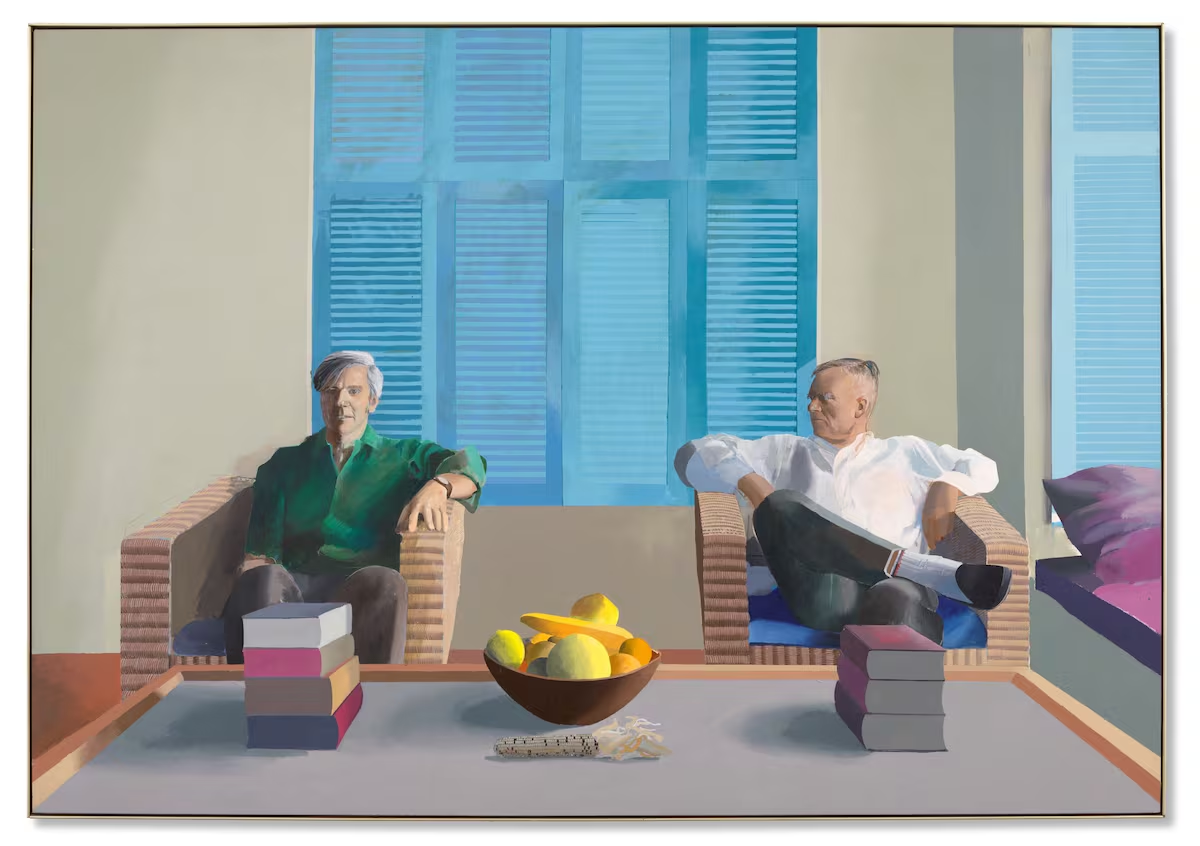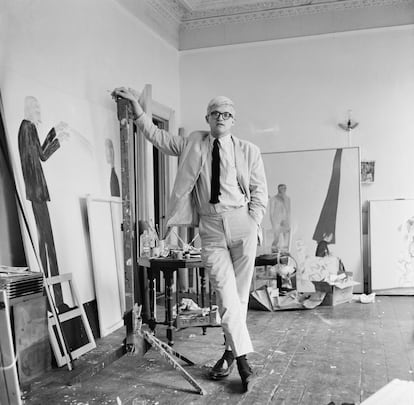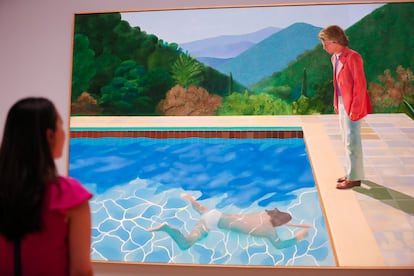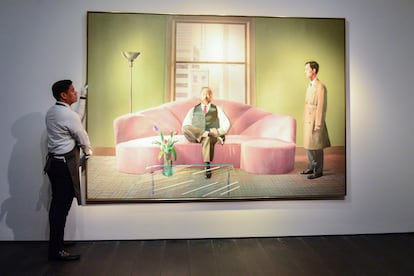
On November 17, during an evening dedicated to the main artistic movements of the 20th century, Christie’s auctioned the first of the double portraits that the British painter David Hockney created in the mid-1960s. This painting is the last of the series of works that remained in private hands and which changed the course of his painting, becoming a point of reference for Pop Art and gay visibility.
Only seven of these portraits exist. Four of them are owned by public institutions, and another two have recently changed hands, subsequently becoming the two highest prices ever paid at auction for Hockney’s works. It was therefore expected that this, which has been in the same collection for 40 years, would break the artist’s records again.
The painting was finally sold for 44,335,000 dollars (approximately 38,495,000 euros), a figure far from the highest prices achieved by the artist in the past, but still above the budgets of public institutions. The unknown buyer probably appreciated the exceptional story of the painting and the two figures depicted: a pair of men having a publicly known romantic relationship: the British writer Christopher Isherwood and the American artist Don Bachardy.
To understand the meaning of this work we must go back to 1964, when the British painter David Hockney decided to leave England and move to Los Angeles, California. He had neither a job nor a place to live there. The painter never fully explained his reasons for moving, but in retrospect, leaving London and going to a place more receptive to his social and emotional needs was a very sensible decision.

Before his move, Hockney was already a household name. Between 1960 and 1961 he participated in the famous Young Contemporaries exhibitions with works in which pale pinks and blues peek out among the blacks and grays of the abstract expressionism that dominated those years. In 1962 he graduated from the Royal Academy of Arts with a painting of a male nude inspired by those in the men’s magazine American physicistwinning the gold medal that year. Also in London, in his Notting Hill studio, he began to paint scenes of intimacy between men in domestic interiors, with floral-patterned furniture and a closed, claustrophobic atmosphere. He also made his first trip to New York, where he met Andy Warhol and Henry Geldzahler, curator of the Metropolitan Museum.
But Hockney needed broader horizons and brighter colors. So in 1964 he moved to Santa Monica, opened his own studio and realized that cycling wasn’t the right way to get around the United States, so he got his license and bought a car.

Dreaming of California
The truth is that California had become the destination of choice for several generations of outsiders. The climate and the distance from the more traditional American cities, with their very closed social structures, had attracted first the exponents of the film industry at the beginning of the century and then, after the Second World War, the beatniks and the counterculture.
Hockney’s painting underwent a significant transformation upon encountering the light and colors of the American West Coast. Skies turned blue, showers opened outward through large windows, and swimming pools became their favorite subjects. As Julio Pérez Manzanares, professor of Aesthetics and Theory of Art at the Autonomous University of Madrid (UAM) and author of numerous books on Pop Art, explains: “It is a return to a very classic figuration, but which also reflects a media-saturated society. The importance of his Californian works lies in the perspective they offer on a world which, for him, is much more modern than England, a world symbolized by those swimming pools and the much freer atmosphere, even in matters sexual, which is found in the American West Coast”.
Hockney has become the chronicler of an idealized homosexual society, of gay men with the financial means to own beautiful, modern homes with gardens and swimming pools, where they enjoy seemingly normal relationships. These might now be considered heteronormative, but at the time, traditional domesticity between two men was considered revolutionary and innovative.
Double portraits
In the following years Hockney dedicated himself to creating a series of portraits of couples that emphasized the normalization of a new type of romantic relationship. Using the resources of the traditional double portrait, he transferred all his validated weight to homosexual relationships. “These portraits, which have a certain enigmatic air, are in reality reflections and mirrors of contemporary intimacy. The fact that many of the couples depicted are men is however radically important to document – and historicize – this type of couple (…) they clearly have a queer gaze that becomes physical on the canvases themselves, whose relationships are fundamentally established through the gaze of the subjects and the viewer”, explains Pérez Manzanares.
Between 1968 and 1975, Hockney painted seven of these works: American Collectors (Fred and Marcia Weisman)currently in the collection of the Art Institute of Chicago, it portrays the famous collector couple in front of their very modern cube-shaped house, between a Native American totem pole and a sculpture by Henry Moore. London’s Tate Britain owns the iconic Mr. and Mrs. Clark and Percy (1971), which depicts the painter’s friends in their modern Notting Hill apartment with their cat, and George Lawson AND Wayne Sleep (1972) features friends again, this time a pair of men. Finally, in Chatsworth House’s exceptional collection, alongside drawings by Raphael and Leonardo, is Le parc des sources, Vichy (1970), in which another couple, with their backs to the viewer, contemplate the wooded vista of the French garden.
Like the press kit of the auction notes, these paintings are considered by Christie’s among “the greatest achievements of modern art”. The latter three had remained in private hands until recently and, at the time of sale, achieved the highest prices ever achieved by the artist at auction.

In Portrait of the Artist (Pool with Two Figures) (1972), a male figure appears at the edge of a swimming pool, observing a man swimming underwater. It is an iconic image that has entered the popular imagination and was recreated by the Spanish director Pedro Almodóvar in a scene from the film Bad education. It contains all the characteristic elements of Hockney’s work of that period: the light and nature of California, the swimming pool and the male nude. The painting alludes to the breakup with her then partner, Peter Schlesinger, who observes another man, the swimmer. The scene is actually based on photographs Hockney took in the French villa of director Tony Richardson, the bisexual director of the British Free Cinema movement. The painting sold at Christie’s in New York in 2018 for $90 million, setting a record for a living artist at auction. The relationship between Hockney and Schlesinger was the subject of the famous documentary A bigger splash, since 1974.
In Henry Geldzahler and Christopher Scott (1969), the art curator of the Metropolitan Museum and his partner appear in a New York interior decorated with contemporary furniture. This work was sold for 49 million dollars.
Christopher Isherwood and Don Bachardy (1968) it is the last of the double portraits remaining in private hands. It’s also the first one I painted. Furthermore, it is the most personal and significant of the paintings in this series because, as Pérez Manzanares says, “it represents the culmination of his encounter with a culture – US culture – which, while by no means idyllic in terms of homosexual relationships in the 1960s, presented an idea of modernity in which sexual liberation was, somehow, included”.
The people portrayed were of fundamental importance to Hockney. The writer Christopher Isherwood, also British, had settled in the United States at the start of World War II. Author of the stories on which the musical and the film are based Cabaret (Bob Fosse, 1972) were based on, and also the novel Single manadapted for the screen by Tom Ford, Isherwood had everything to become Hockney’s spiritual and intellectual guide, especially in his home in Santa Monica, which he shared with his partner, the very young artist Don Bachardy.
The painting depicting them was exhibited in Madrid on the occasion of the retrospective exhibition dedicated to him by the Juan March Foundation in 1992, which had a great impact on Spanish artists of the time. For Beatriz Ordovás, director and international specialist of Christie’s Department of Post-War and Contemporary Art, the painting “is a work that marks a key moment in Hockney’s career and in the history of modern portraiture. Isherwood and Bachardy appear as two ordinary individuals depicted in an everyday scene, but at the same time they are two figures of extraordinary influence on the culture of their time”.

Even before the final auction price, economic expectations were very high because “the work has remained in the same private collection for more than 40 years, making it an exceptional appearance on the market and a rare opportunity to acquire a fundamental piece of 20th century art. Everything suggests that this painting will continue to connect with the public and collectors for its beauty, its history and the message of human connection that remains relevant today.”
Sign up to our weekly newsletter to get more English-language news coverage from EL PAÍS USA Edition





